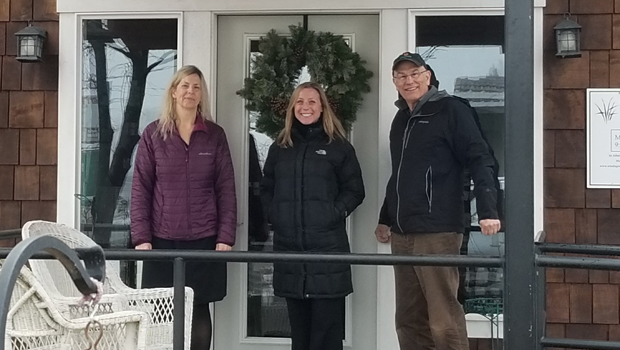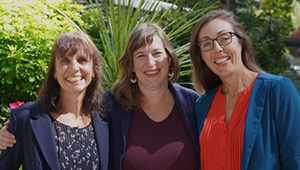Partnership with rural-health experts aims to improve heart care

At Winding Waters Clinic in Enterprise, OR (population 1950): (L-R) Keli Christman, Winding Waters practice manager and Healthy Hearts Northwest small practice advisory committee member; Angela Combe, ORPRN practice coach; and L.J. Fagnan, ORPRN founder.
Healthy Hearts Northwest is helping patients receive better care for cardiovascular conditions thanks to collaborators like Dr. L.J. Fagnan
By Michael Parchman, MD, MPH, Senior Investigator, MacColl Center for Health Care Innovation, Kaiser Permanente Washington Health Research Institute
L.J. Fagnan and I have much in common: We’re both licensed family physicians, we’ve both practiced medicine in rural areas, and we both serve as scientific investigators on Healthy Hearts Northwest, a multi-year research project to help patients reduce their risk of developing cardiovascular disease.
With support from the Agency for Healthcare Research and Quality’s EvidenceNOW initiative, Healthy Hearts Northwest aims to increase the quality improvement capacity of primary care practices through the use of practice coaches.
An early study goal was recruiting 250 clinics throughout Washington, Idaho, and Oregon, including many clinics located in rural areas. Enrollment for big studies like this always involves significant outreach, and these days recruitment is often accomplished via web or phone from a centralized location. Our project design included face-to-face interactions between our team and participants over a 15-month period, which hinged on us building interpersonal trust. So we began building those relationships by doing mostly in-person enrollment and logged many miles driving backroads and highways getting to the practitioners we wanted to reach.
L.J. founded the Oregon Rural Practice-based Research Network (ORPRN) in 2002. We partnered with ORPRN because we knew that the strong relationships his organization has forged would help us reach our recruitment goal. But we were excited to collaborate with him for another reason: Rural health care practices face unique challenges. No one knows rural practice like ORPRN, and we knew that the Healthy Hearts Northwest approach would offer unique support. We were eager to test our approach in rural areas.
I asked L.J. questions about Healthy Hearts Northwest in the context of practicing rural medicine — and here’s what he said.
Q: Can you describe a typical rural practice and the challenges they face?
L.J.: Those who choose to practice medicine in rural areas are special people. Rural physicians attend to clinic, take care of hospital patients, handle emergencies and trauma, deliver babies, and care for citizens in the nursing home. Rural clinicians want to be integrated into their communities in this way.
Rural, or “frontier,” is defined by less than six people per square mile, so that often means more cows than people. Frontier providers try to address the social determinants of health (housing issues, food insecurity, and transportation) along with everything else.
Generally, rural communities can be characterized as having small populations, lacking large health systems and centralized resources, and with a high degree of poverty. Because rural practices don’t turn anyone away at the door, they are the safety net with over 50% of the patients insured by Medicaid (25%) and Medicare (25%). One in five Oregonians lives in a rural area. With our population at 4.14 million, almost 20% of Oregonians live in rural settings.
Q: Why is practice-based research in rural areas important?
L.J.: The bulk of medical research studies happen in academic medical centers, but less than 2% of patients receive care at these centers. Research is about truth, but the truths found in academic medical centers might not actually be true.
Practice-based research collects data from real people in the real world, often living in underserved areas. As researchers, we have a responsibility to make life better for practitioners and the patients they serve. Casting a wider net, using data from a variety of practices and geographies, gets us closer to a generalizable truth.
Q: Why was Healthy Hearts Northwest a good fit for ORPRN?
L.J.: Central to Healthy Hearts Northwest is the use of practice coaching, which has its roots in the agricultural extension agent movement of the 1930s. We have a great team of practice coaches (PERCs, or Practice Enhancement Regional Coordinators) working directly within health systems and fifteen Coordinated Care Organizations (CCOs) throughout Oregon.
Our PERCs made monthly site visits to all enrolled Healthy Hearts Northwest clinics over a 15-month period (and sometimes longer.) We were excited to bring our PERC model into frontier medicine because cardiovascular disease affects rural Oregonians disproportionately. Approximately 40% of rural adults have hypertension and 15% have cardiovascular disease as opposed to 27% and 7% in urban areas. This means that there is a greater percentage of potentially excess deaths from cardiovascular disease in rural areas as opposed to metropolitan areas.
Healthy Hearts Northwest is teaching practices how to fish, as opposed to giving them fish. Rural practitioners like this because they like to be self-sufficient. We’ve given them tools that they can apply to other conditions, like depression and diabetes. In turn, practices teach the health services research community how to adapt the tools to the real world.
Many of the Oregon practices have told me that Healthy Hearts Northwest has made an indelible mark on them.
Q: Practices that join ORPRN agree to provide data for your research studies, like Healthy Hearts Northwest. Does ORPRN offer them anything in exchange?
L.J.: The benefits go both ways. By joining the network, smaller and independent Oregon practices know that they’re contributing to building an evidence base that can lead to better care for rural communities. Participating clinics are eligible for invaluable support from our PERCS navigating today’s shifting health care landscape. Our technical assistance ranges from in-person practice coach help setting up a new EHR to developing innovative ways to compile reporting data to writing federal grants.
Network members tell us that ORPRN has played an important role in collegial support, practice improvement and stability for many of them in rural and remote areas of the state. They feel engaged in a network-wide dialogue about merging the varying accomplishments that we’ve had through the years into a coherent and sustainable vision for Oregon’s future.
Q: You do a lot of driving! You try to visit each ORPRN practice in-person every year. Why is this important?
L.J.: It’s hard to recruit busy practitioners for studies, but there’s no substitute for doing it in person. Recruitment needs to be a give and take. We make practices aware of opportunities while also finding out what challenges they face. Rural practices are increasingly expected to report data and quality metrics, so I tried to find out what each was doing with that. For Healthy Hearts Northwest, I’d explain that we’d be looking to get data to reduce stroke and heart attacks, and that we think primary care is the right place to institute this. I’d tell them I thought it might work with their practice. You can’t do that by email. You have to show up, make “home visits.”
Also, I visit practices because I get inspired by them. I see how providers are caring for their community, and come away thinking, “Medicine’s a good job, and we do really good things for people.”
Q: What preliminary discoveries has Healthy Hearts Northwest made about rural versus urban Oregon medical practices?
L.J.: We found that rural Oregon practices were more likely to sign up for Healthy Hearts Northwest than urban practices. One in four rural practices approached for our project signed up as opposed to one in ten urban practices. Oregon rural practices were also more likely to complete the study. The urban dropout rate was 29% as compared to a rural dropout rate of 15%.
The rural practices loved in-person visits from Healthy Hearts Northwest. It was more of a sales job with urban practices.
Q: What’s on the horizon for rural medicine?
L.J.: We have yet to make rural practice a place that attracts medical students and other health professionals. We need a training program that trains local people to fill roles in rural medicine. New physicians leave medical school with huge debts, and they shouldn’t have to sacrifice income to work in frontier areas. And we need to identify and promote a business model for a patient-centered and community-centered primary care practice — and ensure that it’s sustainable.
It used to be that education was the number one employer in rural settings, but now it’s health care. And if no providers want to or are able to sustain life in a rural community, there’s much more at stake than losing health care; the whole community may die.
Q: I think the isolation of the rural landscape has driven you to do your work. Can you talk about loneliness?
L.J.: I grew up in and am drawn to rural areas, which is typical of folks working in rural medicine. I started my own family medicine career working in Alaska with native Americans. My daughter was born in a native village. When you’re in rural practice, you make do with what you have, and you learn to solve problems on your own. It’s what we know and love.
And it’s hard work out there. Doing what we love comes with a cost and responsibility. At any given day in a rural practice, a life might be at stake. Providers wonder, “Does someone have my back?”
That loneliness of wondering if I had any support has been a motivator for me, and what’s led me to seek out other people. Voices from Left of the Dial is a paper I co-wrote about the reasons practitioners get involved in such difficult work. The conclusion we ended with is that practice-based research is the antidote to loneliness.
Learn more about Kaiser Permanente Washington Health Research Institute. Sign up for our free monthly newsletter.
ACT Center

New center focuses on equitable, whole-person health care
Kaiser Permanente launches the Center for Accelerating Care Transformation.


